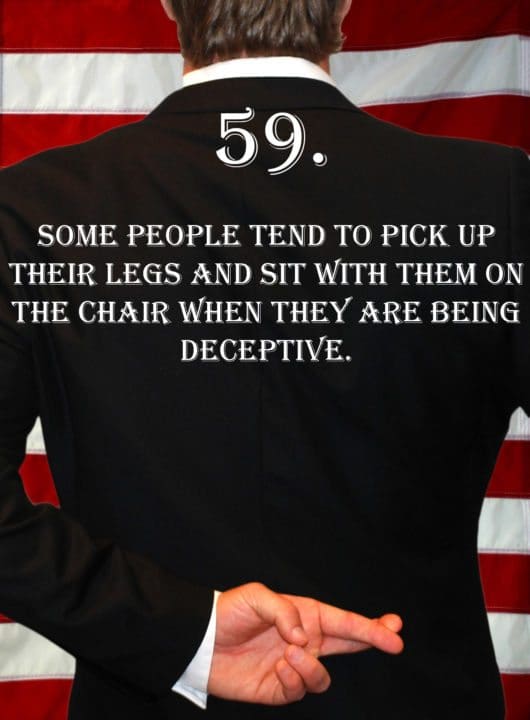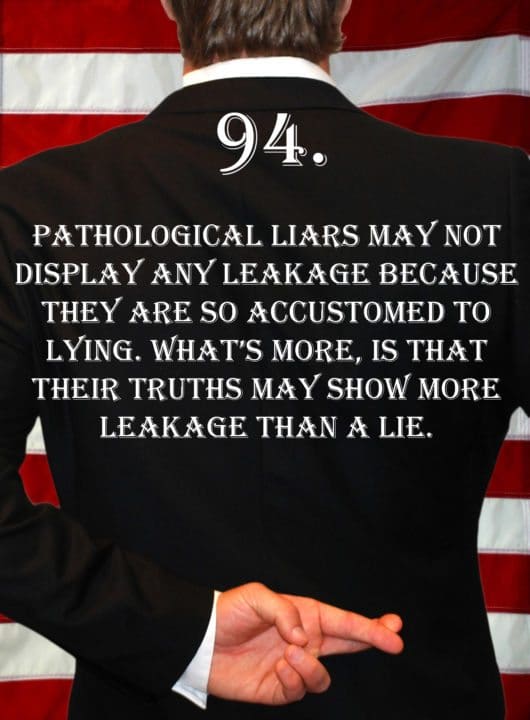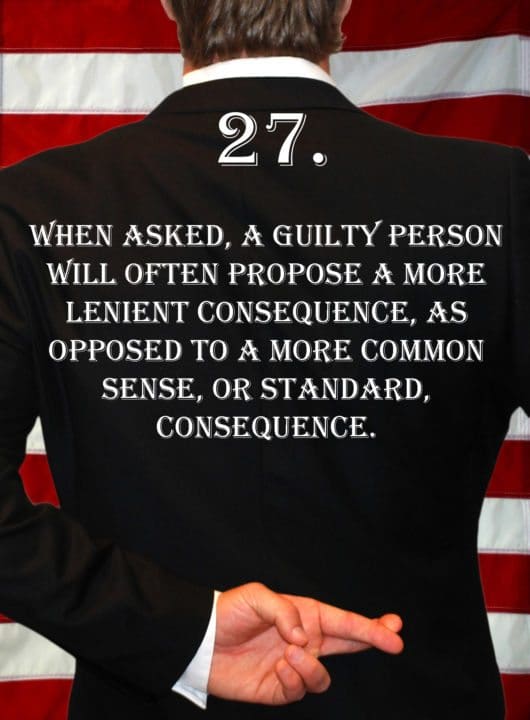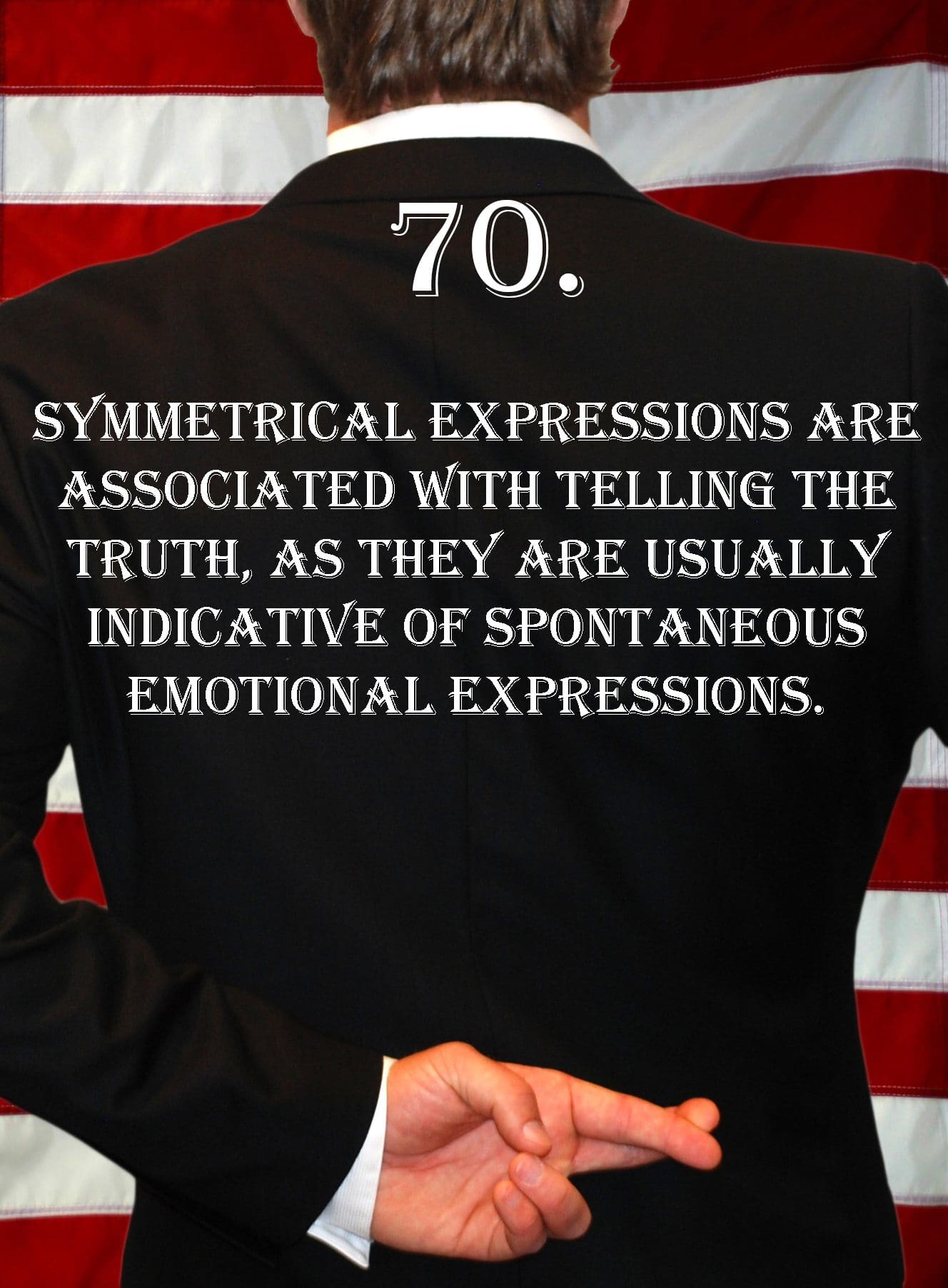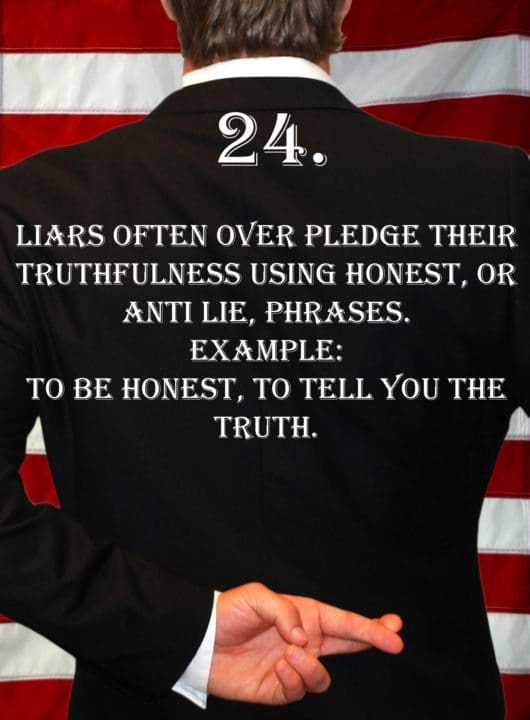
Deception Tip 24:
Liars often over pledge their truthfulness using honest, or anti lie, phrases.
Example: To be honest, To tell you the truth.
Listen To The Podcast!
E24 – Pledging Truthfulness – Deception Tips Podcast – Click Here To Subscribe
Podcast Transcript
Hello and welcome to the deception tips podcast, where you will learn amazing cues to detect deceit that will help you to read people like never before- I’m your host, Spencer Coffman. Let’s get started.
Welcome to episode 24 of the Deception Tips Podcast. Last time, we spoke about a sign of deception that was something along the lines of symmetricality and symmetrical expressions.
We’ve talked about this a lot over the past few episodes- over the past few months really. Way back in episode 12, were simultaneous gestures. Episode 14 was symmetrical expressions and episode 16 was symmetrical gestures.
Then, we also spoke of the left side of the face last week- episode 23. This was about how the left side of the face is controlled by the right cerebral hemisphere, which is more dominant in false emotions or deception. This means those will be displayed more on the left side of the face. So, you should watch the left side of the face, especially when it comes to emotional expressions.
Now, keep in mind that these incongruencies and symmetrical/signs will only appear for a split second. They’ll be very quick- very brief- and the masking behaviors that come along with them will also be very brief and very short.
And then, the overcompensation, which leads to the end result of asymmetricality will also be very brief. So, it could all happen within a split second, or within a fraction of a second. So, you need to be paying very close attention to this and watch out for these different signs of deception.
Now, obviously, the inconsistencies within speech and body language will be more readily apparent and you won’t happen over more lengthy periods of time. However, the emotional expressions of asymmetricality that are displayed on the face will be split seconds, and fractions of a second that you need to watch for and see.
It is a form of micro-expression and is something that you will learn to pay attention to and watch for. And it is a skill that you must train yourself to develop and then you will be able to see it.
However, it’s something that, once you start seeing, you’ll be glad you’re seeing it or you’re going to lose your mind because of it because you’re going to start seeing things in everyone including yourself.
So, make sure to watch out for symmetrical expressions. Remember the science behind it all; that the body and brain are contralaterally related. So, anything that happens on the right side is controlled by the left side of the brain. Anything on the left side of the body is controlled by the right side of the brain. Understand that. Look into more of the different sides of the brain- some of the rationale behind it.
The left side is more logical/rule-oriented which would be why the right side of the body is more truthful because the truth usually rules. Whereas the right side of the brain is a little more free-spirited, artsy, crafts type of a thing, spatial.
That could be why the left side of the body has more deception because, if the right side of the brain controls it and it’s a little bit looser, let’s say, and more rule-oriented, then it may be more willing to break those rules and be deceptive.
Keep in mind some of that. You can look into it and learn more about the intricacies of the brain, mind, and body, and how it all interacts with one another, the science behind it, rationale, logic, whatever is up your alley to kind of help you understand how this all happens.
And, that it is, in fact, a science, it is not simply a pseudoscience as some say. This really is a science. You can see people who are being deceptive. The signs are out there. They are universal and they are across all humanity. Even if you don’t speak their language, you could still see these signs on someone and know whether or not they are being deceptive.
So today, we are going to talk about another sign of deception. This one, you wouldn’t really be able to do if you don’t know their language because it involves speaking and it involves certain phrases that people use. So, you would have to understand that. But, it still is universal and they will use it in other countries.
However, the phrases will be different because depending on their culture, and the type of language that they use, there will be different variations of the examples that I will give you today. However, the bottom line- the principle- will be the same across all cultures and across all races because, like all of these expressions we are talking about and the signs of deception, they are universal and they will happen all over.
So here it is. Deception Tip 24: Liars often over-pledge their truthfulness using honest, or anti-lie, phrases. Example: “To be honest…” and “To tell you the truth…” Here it is again. Liars often over-pledge their truthfulness using honest, or anti-lie, phrases. Example: “To be honest…” and “To tell you the truth…”
So, this sign has multiple parts as in all of our signs lately. We’re kind of getting into multiple parts. We’re starting to incorporate some more clusters, some patterns, we’re building on things, we’re getting a little bit deeper in what we are doing which is great because now, you have a good repertoire of signs that you can use in your everyday life, in your conversations. You can watch people and you’ll see more of these as you review them and look at the other resources- the blog, the books, etcetera.
So, liars often over-pledge this truthfulness. They, as we’ve said, they want to convince not only the target of this lie but also themselves. And, this is primarily the reason for this over-pledging of truthfulness because they are over-pledging it to convince themselves of the lie.
It is their unconscious and conscious battling it out. And, this extra over-pledging, these examples that they use to kind of convince the unconscious, “Hey, it’s ok.” To get it to let up a little bit.
So, the conscious and the unconscious, as we’ve talked about before, are battling back and forth. And, these anti-lie phrases are brought about, in part, kind of by both. Usually, it’s the other. But these, are brought about consciously as a form of emphasis, and unconsciously, as a form of leakage.
So, it’s kind of teamwork there, but they each have their own purpose with this agenda. So, this is one area where they’re kind of- let’s just say- in agreement even though it’s really one and the same thing and I talk about them like they’re battling back and forth.
But, they aren’t two different entities, the conscious and the unconscious, it’s similar. You understand the picture of it, but this gives you a good visual of what’s going on. So, they both bring it out.
The unconscious has the purpose of using this as a sign of leakage. The conscious has a purpose of using this as a sign of convincing the unconscious and convincing itself, the conscious, of the lie.
So, those two examples are something that you’ll hear often and they usually come about in parts of sentences or phrases which we will talk all about- right after this.
Are you loving this podcast? If so, consider writing a review on Itunes, Google, or wherever you’re listening. Reviews help others find this podcast so they can learn how to spot lies as well.
Honest, or anti-lie phrases, are in all shapes and forms. The two that I gave you, “To be honest…,” and, “To tell the truth…,” are some that, oftentimes, come at the beginning of a sentence or before a phrase.
As with most anti-lie or honest phrases, they usually come at the beginning of someone’s statement or right before they are about to say something. So, you may ask a question for their advice and they say, “To be honest with you, I’d do this or this.”
You hear this a lot of times with people who are getting estimates or bids. Someone comes out to your house and they’re going to put in a new backsplash or they’re going to send down the roto-router down your pipes, clean things out and they say, “You know what? To be honest with you, I’d do it every six months.”
Well, do you really need it every six months or are they doing that to drum up some more business? Something like that. They say, “To be honest with you, this is going to be a real pain. It’s going to be a lot more work than you think.” Really? That’s why I’m hiring it done.
So, these types of phrases- people use them all the time and sometimes they use them without thinking about them. Well, most of the time they use them without thinking about it. It’s kind of a habit. It kind of slips out almost.
But, the conscious and the unconscious know what they’re doing, but the person’s front- their thought processes- they’re not consciously thinking about using these phrases. They’re just kind of coming forward in their normal conversation and they think it’s normal, but really, it’s not.
They’re normal in the fact that we hear them a lot, but they’re abnormal in the fact that they have some other form of meaning. Kind of an ulterior thing going on there.
When someone says, “To be honest, I would do this, this, this, and this.” Ok? Well, what if you’re dishonest? Then what would you do? Things like that. It doesn’t really make any sense and, when people say that all the time- If I say, “To be honest with you, I’d do this.”
Ok. ‘Well, to be honest’ does that mean you normally lie? You’re normally lying all the time, but this time you’re giving me some honest advice because you said, “To be honest?” So, this time you’re giving me honest advice, but normally all the advice you give me is a lie. Ok. That’s nice to know. See you!
So, those types of things can backfire on people if people think about them. And when I point that out, you realize how stupid that is to say something like that. So, if you’re one of those people that say that, maybe start considering that. That might be you might not be getting through to people. Who knows? But consider that.
Another one people use all the time is, “I’m not going to lie. That was pretty awesome.” Or, “I’m not going to lie. I’d do it like this.” Or, “I’m not going to lie. That was some really good pie.” You know, they might use that type of intro statement, and that again.
Ok. So, you say you’re not going to lie. So, normally you lie then. That’s what that means. Normally you lie, and you give me a false answer, but today you say you’re not going to lie and give me the truth. I understand how it works.
So, they’re kind of rationale that doesn’t make sense and they use it as an emphasis. They’re over-pledging their truthfulness. They’re saying this to try to reinforce that what they’re saying is true. They want it reiterated.
It’s kind of like when we talked about the contractions when they split apart a contraction. We talked about this way back in episode 5 when people say, “I did not…” Remember we brought up Clinton’s famous one, he’s come up numerous times in his episodes. “I did not.” They split that out.
Or Nixon, “I am not.” He split that out. “I am not a crook.” They split apart the contraction to further emphasize their truthfulness or to put more emphasis on what they were saying.
It’s the same thing here. They’re over-pledging their truthfulness. “To be honest…” “I’m not going to lie…” Because then whomever they’re talking to, the target, hears “honest” not “lying.” Ok, maybe they’re telling the truth.
They think it’s going to fool them or break through a barrier and kind of help ease it through. Now, obviously, the liar is not consciously thinking about this, but that’s kind of the strategy behind it up in their head. That it’s going to try to ease it in and make it sound a little more believable.
The other one, “To tell you the truth, I would go left here and right here at the gas station.” Or, “To tell you the truth, I would only run 89 in your gas tank.” Oh, yea. Of course, because it’s more expensive or whatever the case may be.
When people use those types of statements, “To be honest.” “I’m not going to lie.” “To tell you the truth.” Or, a whole slew of other ones, that reemphasize what they’re going to say and that further emphasizes that “Hey, I’m telling the truth.”
Or, “I’m only going to say this once.” Things like that. That’s a little bit of a different track. It’s not quite the over-emphasis or pledging truthfulness that we’re talking about here, but that’s another one that you can be aware of and we’re going to talk about it in a future episode.
So, keep listening because we’ll get to it. But when people say, “I’m only going to say this once” or “Listen up because this is important,” or things like that. Ok, really? “Listen up because this is important.” So, everything else you said is not important. I understand. Stuff like that.
So, you can think about those introductory phrases that people use before they say a statement. Most of them can be thrown out because they’re garbage. It’s something that is used to add value and emphasis but it’s false value and false emphasis because most of the time they’re unimportant.
They’re trivial. They’re meaningless. They’re only done to try to add hype to the situation so that they will be more believed. And it’s also, not only that they will be more believed by other people it also to convince themselves of the lie as we have said many times before.
They say this: “To be honest,” and then they follow it with a lie, but they said, “To be honest,” to try to convince themselves that it isn’t a lie that’s following. People always want to convince other people and themselves of their lies because there’s tension. It’s always a battle. Lying is a tough deal unless people are just naturally good at it.
In which case, we say that they have some sort of psychological disorder. Usually psychopathic, or sociopathic, individuals- other types of narcissistic, perhaps, or alter-ego personality type disorder- that make them really good at lying or they don’t feel any emotion when they’re lying and, in this case, none of these signs would really apply to them anyway. So, it’s not valid.
But, people always try to convince other people of their lies otherwise, they wouldn’t be lying. There would be no reason to convince so there would be no reason to do it. So, watch out for these over-pledging statements that happen.
Look for the inconsistency with it. “To be honest.” Ok so, this time you’re honest. Or, “I’m not going to lie.” Ok so, this time you’re not going to lie, but normally you lie.
You know, point out those kinds of “duh” moments and those stupid things that could be when you start to think about it logically and you’ll realize that a lot of these introductory statements don’t make sense. This means that what comes after could be a lie or what was said before could be a lie.
Now, it’s up to you to look for other signs of deception and patterns of behavior to determine if what they are going to say next is a lie or if what they said before was a lie.
That’s where you need to use your other repertoire of skills, signs of deception, body language, and things that you’ve learned, to kind of pick apart what they’re doing and see where the truth is and where the lie is. And, if you do that, you’ll be well on your way to detecting deception.
I want to thank you for tuning in this week to the Deception Tips Podcast. I encourage you to share it with your friends, subscribe to the feed, check out the Deception Tips blog, and take a look at the books I have available. And as always, tune in next week for a new Deception Tip.
Video Transcript
Hey guys, my name is Spencer Coffman, thank you for watching the Deception Tips Videos. They’re all about teaching you how to read people and detect deception so that you will be able to tell if someone is lying to you.
Today we are going to talk about a verbal technique that liars use to try to be more believed. It is something that they incorporate into their speech without even knowing, and this, the reason they do this is because a liar’s primary goal is to be believed. They want people to believe their lie. Otherwise, they wouldn’t be telling it. They’re not going to just tell a story and then hope that no one believes it. They’re going to tell the story and hope that people believe it.
Because they are trying to hide something or get away with something, or XYZ, whatever they’re trying to do, they are trying to make others believe what they’re saying. So they incorporate a few key phrases into their lie so that other people will be more likely to believe them. This is called pledging truthfulness, and today we’re going to talk about
Deception Tip number 24: Liars often over pledge their truthfulness using honest, or anti-lie phrases. Example: to be honest, and to tell the truth.
So this is important because they’ll use this anti-lie, or honest, phrases. Now, these usually come before they’re telling the lie. Also, they may say, “well to be honest with you, I would recommend using the blue color over the red color,” or something like that.
Now, what they don’t realize is that using that statement, from a common sense perspective, it makes no sense. So if I say, “well, to be honest with you, I recommend this one over this one.” Okay so wait a minute, normally you’re telling me that you would lie, but this time you’re saying to be honest you’ll, you’ll choose this one? So it doesn’t make much sense, because then that would mean that well, normally they’re a liar, and this time they’re saying “to be honest,” so, they’re going, to be honest this time. Or, “to tell you the truth, I would say this.”
So that means normally you’re lying, and today you’re saying, “I’ll tell you the truth.” Or another very, very popular one is when people are trying to recommend something, or when they think something is cool, they say something like, “well I’m not going to lie, but I like XYZ.” And all of these statements, these pledging truthfulness, or these anti-lie phrases, are done without thinking, but really what’s happening is the unconscious is putting them out there, counting on the fact that people, the targets, are going to realize that something’s off. That it doesn’t sound quite right.
It’s not really normal speech, or it doesn’t sound like it should make sense, it’s not a common sense perspective. And the unconscious is leaking that verbal behavior, or that verbal cues, to let that lie get caught. And the conscious is thinking that it’s reinforcing the truth, it’s saying, “well I’m not going to lie, that means I’m telling the truth.” Yeah but, in reality then, that means you lie all the time, and today you’re telling the truth. So you can see how that, it doesn’t quite match.
So when you hear people use these, number one, it could just be a bad habit that someone has developed, so they may not really be lying all the time, they just may have never thought about it. Some people say a lot of words without thinking and they developed a form of habit, and it’s just kind of like filler speech. Sort of like when people who are speaking say “um” a lot. If they don’t have a lot of practice, they say “um”, or they say “ah”, or things like that.
They incorporate them into what they’re saying without even thinking about it. It’s just kind of a filler to help them think. They may be using these statements as a filler to their natural speech and they may not even know what they’re doing. But once you point it out to them, then they’ll start thinking about it, and then they’ll probably stop because you’ll realize how, how stupid it sounds and they’ll say, “oh man, I don’t want to sound like that.”
Or, so when you hear them, that’s the number one is either they don’t know what they’re doing and it’s completely innocent and harmless, or number two, it is an unconscious behavior that is leaking out, trying to cover up a lie. And in that case, watch out for some other verbal and nonverbal behaviors, that you can find and spot, so that you can put together some patterns and clusters of behavior to determine whether or not they are indeed telling a lie.
If this is your first time watching these videos, I would love to have you subscribe to the channel on YouTube. In addition, feel free to comment with any questions you may have. Also, if you’d like some more information, we have books, blog posts, podcasts, all available on SpencerCoffman.com that are dedicated to teaching you exactly what every body is saying.
Until next time.


